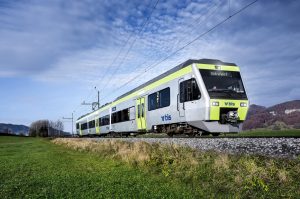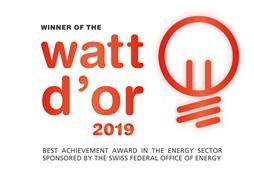Contact: Andreas Schueler

To reduce electricity consumption in rail transport, the focus of research and development today needs to extend beyond traction systems efficiency to the electricity consumption of comfort systems such as heating, ventilation and cooling (HVAC), which are responsible for an increasingly large part of total energy consumption.
This part naturally depends on many different factors that were little known until recently. As an order of magnitude we can speak of approximately a third of the total energy consumption of a train or a trolleybus, although there are considerable differences between trains such as for example highspeed IC trains (which use considerably more energy for traction) and regional trains with relatively long waiting times between individual runs and frequent opening of the doors.
The construction of an entire vehicle envelope including glazing and the efficiency and control of HVAC components are naturally other factors that influence the energy consumption of comfort installations. Besides the targeted energy efficiency of people transporting wagons, the comfort of travellers with regard to daylighting and sun protection needs to be given special consideration.
In the framework of a large project with multiple partners among which many railway companies, EPFL/LESO-PB has been responsible for the investigation of the relevant aspects of the vehicle envelope are investigated. This includes new or better insulation materials, solar protection of the glazed surfaces as well as optico-thermal characteristics of the wagon roof and side walls. The thermo-optical data of the opaque and transparent elements of the vehicle envelope are characterized precisely. The results serve as a basis for dynamic thermal models. For the different transparent and opaque parts of the vehicle envelope, new materials and coatings are developed. Furthermore, envelope improvement proposals taking into consideration access to materials and the whole lifecycle of the construction groups are developed. Besides aspects purely related to energy consumption, daylight availability and visual comfort of the travelers are of central importance in this work.
So far, our studies on the topic have already inspired novel ideas for improved glazing and smart thermal insulation materials for trains and trolleybuses.
Train windows that combine mobile reception and thermal insulation
In the framework of this research program, the LESO-PB group has developed frequency-selective sufaces, which allow telephone waves to pass through high insulation windows, which usually create a Faraday cage due to their metal layer. This invention now used in BSL trains received considerable media attention as well as two awards. Read more.
Main publications
O. Bouvard, L. Burnier, P. Oelhafen, A.Tonin, P. Wüst, F. Sidler, G. Zweifel, A. Schüler, Solar heat gains through train windows: a non-negligible contribution to the energy balance, (2018) Energy Efficiency, 11 (6), pp. 1397-1410. DOI: 10.1007/s12053-018-9643-7
Luc Burnier ; Matteo Lanini ; Olivia Bouvard ; Damiano Scanferla ; Abiraam Varathan ; Carine Genoud ; Arnaud Marguerit ; Bernard Cuttat ; Noémie Dury ; Reiner Witte ; Andrea Salvadè ; A. Schüler, Energy saving glazing with a wide band-pass FSS allowing mobile communication: Upscaling and characterization, in IET Microwaves, Antennas & Propagation, DOI: 10.1049/iet-map.2016.0685
Structured transparent low emissivity coatings with high microwave transmission, in Applied Physics a Materials Science and Processing, vol. 123, num. 66, 2017. DOI: 10.1007/s00339-016-0701-8
Awards
RailTech 2019 Innovation Award, Utrecht, to Andreas Schüler, Olivia Bouvard, Luc Burnier, Jérémy Fleury, for Energy efficient windows that transmit telephone signals.
Watt d’Or 2019 awarded by the Swiss Federal Office of Energy, Category “Energy-efficient mobility” – Retrofit of 36 NINA suburban trains with LESO-PB’s novel technology of microwave-transparent insulating glazing, in collaboration with BLS and the University of Basel – P.Oelhafen, C. Isenschmid, A. Schüler et al.

In the media – New train windows allow mobile phone waves through while keeping excellent energy efficiency:
RTS – CQFD: Réception mobile dans les trains: une solution de l’EPFL
RTS : Des vitres de trains traitées au laser pour faciliter les coups de téléphone
20 minutes : Nouveau vitrage pour mieux téléphoner en train
Tribune de Genève : Nouveau vitrage pour mieux téléphoner en train
24heures : Nouveau vitrage pour mieux téléphoner en train
24heures: Des vitres innovantes conjugent isolation et téléphonie mobile
Tages Anzeiger : Besserer Handyempfang im Zug dank neuer Fensterscheiben
Berner Zeitung : Besserer Handyempfang im Zug dank neuer Fensterscheiben
St.Galler Tagblatt : Neue Zugfenster lassen Mobilfunk durch
Neue Luzerner Zeitung : Neues Glas für Zugfenster lässt Mobilfunk durch
EPFL Flash: Train windows that combine mobile reception and thermal insulation
EPFL News
https://actu.epfl.ch/news/bls-equips-29-trains-with-leso-pb-developed-techno/
https://actu.epfl.ch/news/leso-pb-technology-helps-win-the-2019-watt-d-or/
https://actu.epfl.ch/news/train-windows-that-combine-mobile-reception-and-th/